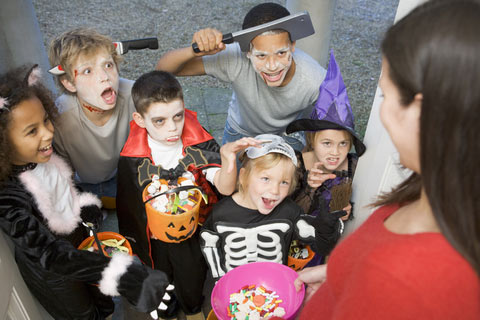Spooked? Kids Must Face Fears

Ghosts, goblins and creepy Halloween fare might be just what the doctor ordered for some kids. New research finds the best way for children to overcome their fears is to face them.
While fear of everything from spiders and gore to social events and separation from parents is normal in kids and adults (to some extent), when such fears get in the way of normal living there's a problem, say researchers.
A typical treatment called cognitive behavioral therapy involves both having kids face their fears along with teaching relaxation techniques and some mental tools to beat down those oversized anxieties. Turns out, having kids face their fears, such as calling up friends for social events to beat social anxiety or staying in a room alone without parents, is the best prescription.
Past research, however, has shown that Halloween fright can be a little heavy for some kids.
"We have children face their fears, and we teach them techniques for managing their anxiety, but research isn't advanced enough to show which element should be the main part of treatment or whether both parts are necessary for improvement," said researcher Stephen Whiteside of the Mayo Clinic in Rochester, Minn.
The research will be presented as a poster today at an annual meeting of the American Academy of Child and Adolescent Psychiatry in Chicago.
Whiteside and his colleagues looked back at the treatment and outcomes among 44 patients ranging from 4 to 18 years of age. The researchers compared their clinical practices with protocols recommended in treatment manuals.
Get the world’s most fascinating discoveries delivered straight to your inbox.
Some of the kids were afraid that something would happen to them or their parents when separated, while others were afraid of making play dates or attending other social events. Other children had so-called generalized anxiety disorder and worried all the time.
The researchers found that while the manuals state therapy should last for about 16 appointments, with exposure to fears beginning at session 10, Whiteside's team found success in an average of nine appointments with exposure beginning on average at session three.
As children were taught to face their fears, each kid's ability to function also increased. That meant kids were able to do more kid things, which were hampered prior to treatment by their fears. The more children focused on other techniques for managing their anxieties, such as relaxation or practice changing one's thoughts from fearful ones to those that are more accurate, however, the less improvement they showed in functioning.
For parents wondering whether or not their kids need therapy for fears, Whiteside gives a broad guideline.
"If they have fears or worries that are stopping them from doing things that other kids are able to do," Whiteside told LiveScience, "if they're stopping them from playing with friends or stopping them from being able to do what they have to do at school, or if kids are feeling or parents are noticing that kids are very upset or distressed because of their worries and fears, that's when they need to get help."
Jeanna Bryner is managing editor of Scientific American. Previously she was editor in chief of Live Science and, prior to that, an editor at Scholastic's Science World magazine. Bryner has an English degree from Salisbury University, a master's degree in biogeochemistry and environmental sciences from the University of Maryland and a graduate science journalism degree from New York University. She has worked as a biologist in Florida, where she monitored wetlands and did field surveys for endangered species, including the gorgeous Florida Scrub Jay. She also received an ocean sciences journalism fellowship from the Woods Hole Oceanographic Institution. She is a firm believer that science is for everyone and that just about everything can be viewed through the lens of science.
